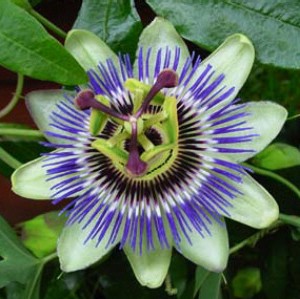
|
|
Blue passionflower
(Passiflora caerulea) the most common cultivated species.
|
Passiflora
- Passion Flower (Passiflora spp.)
The gender
of Passiflora consists of about 600, tender, evergreen and deciduous, climbing
plants that are mainly natives of tropical South America.
Passiflora were introduced to Europe from South America in the Eighteenth
Century, principally by the Spanish, & can now be found in many parts of the world including
Africa, Asia, Australia & North America. Most Passiflora are vines thought to have originated in either the cooler mountains or the much hotter tropical rain
forest.
Passion flower got its name from descriptions of its flower parts supplied by priests in the
'New Spain' (South America). These were interpreted in 1609, by Jacomo Bosio in
Rome, as representing various elements of the Crucifixion, five petals and five sepals
(the ten disciples, minus Judas & Peter); outer fringe (the crown of thorns); five stamens
(number of wounds Christ received) & knob-like stigmas of the pistil (the
nails). This symbolism is not universal however, in Japan
adn in Greece it is known as 'The Clock Plant'.
To survive & reproduce in these very competitive environments many species grow quickly using their tendrils to climb up trees (a very few have adapted becoming trees
themselves) to reach the forest canopy & full sun, at which time the trailing stems begin to
flower. To attract pollinators, such as bees, moths, butterflies & other
insects, bats & hummingbirds to them rather than to other plants, Passiflora have evolved a wide variety
(made wider by our man made hybrids) of stunning colourful flowers, often
perfumed, with additional sweet nectar glands on leaves, petioles & sometimes
bracts. In addition the fruits, which must be eaten to spread the plant over a wide
area, contain a juice with a unique aromatic taste & smell.
Classification of Passiflora was first done by Linnnaeus in 1745 when he recognised 22
species. There are now thought to be over 600, but many are under threat in their natural rainforest
habitat. Hybrids were first produced in UK in the 1820's - the first one, P. x
violacea, although its correct name is disputed, is still with us. Popular with the Victorians in
UK, Passiflora became less fashionable in the early Twentieth Century, but now there is worldwide interest in them both as a commercial crop with new varieties being introduced & as an exotic decorative addition to
gardens, conservatories & greenhouses. In addition P. incarnata is used by herbalists as a mild sedative & there may be further medicinal uses of other
species.
Passionflower (Passiflora
incarnata) was used in traditional remedies as a
"calming" herb for anxiety, insomnia, seizures, and hysteria. During the early twentieth
century, this herb was included in many over-the-counter sedatives and sleep
aids. In 1978, the U.S. Food and Drug Administration (FDA) banned these preparations due to a lack of proven
effectiveness. In Germany, however, passionflower is available as an over-the-counter sedative
(in combination with other calming herbs such as valerian and lemon balm). It is also used in German homeopathic medicine to treat
pain, insomnia, and nervous restlessness. Today, professional herbalists use passionflower
(often in combination with other calming herbs) to help treat insomnia, tension, and other health problems related to anxiety and
nervousness.
Passionflowers, also called granadillas because the fruits look similar to those of pomegranate - " granada " in Spanish - produce eatable
fruits, provided that they should be eaten raw to avoid being toxic. All species of this gender are
eatable, although there are some that are more appropriate as food than others.
Passiflora incarnata, it produces a fruit that sometimes reaches the size of a melon . It is generally consumed in marmalades in some southern states of USA It was already used by the old Aztecs to treat the bites of the
snakes, reason why is was known as " Tongue of snake" and the first Indian natives used it like a food and as
disinfectant.
Source:
http://www.passionflow.co.uk/history.htm
http://www.umm.edu/altmed/ConsHerbs/Passionflowerch.html
http://www.botanical-online.com/texascastellaflora.htm
